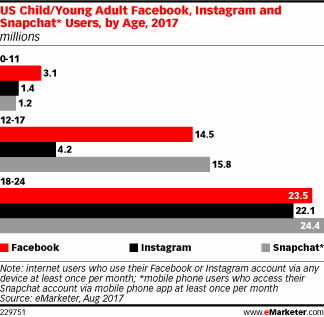For the better part of the last decade the ideal for most new social media companies has been to become “the next Facebook.” That company has grown to the role of the 800 pound gorilla in the space. Over half the world’s population uses the network and that massive reach has brought with it a dominant role in the online advertising world, sucking up a gigantic portion of overall spending.
Fault lines have been appearing here and there for a couple years that have hinted at weakness in the company’s growth potential. Most of those have been anecdotal, though. Now there are some serious numbers that show we may be witnessing the beginning of the end of Facebook’s dominance.
Facebook Falling In Appeal
 A new eMarketer study forecasts slow growth for Facebook in the coming years, particularly among teens and young adults. Those young, influential individuals who are prized by advertisers for their buying power and lack of entrenched brand loyalty will be increasingly, the study says, migrating to Instagram and Snapchat. Those platforms have done a better job of adapting to the different communications needs and styles of the younger demographic than Facebook and will reap the benefits of that appeal. Even worse, those kids who are just becoming old enough to join social media appear to be bypassing Facebook altogether.
A new eMarketer study forecasts slow growth for Facebook in the coming years, particularly among teens and young adults. Those young, influential individuals who are prized by advertisers for their buying power and lack of entrenched brand loyalty will be increasingly, the study says, migrating to Instagram and Snapchat. Those platforms have done a better job of adapting to the different communications needs and styles of the younger demographic than Facebook and will reap the benefits of that appeal. Even worse, those kids who are just becoming old enough to join social media appear to be bypassing Facebook altogether.
That’s not all bad news for Facebook since, as the story says, it owns Instagram as well. But it opens up the possibility that within the next five years Facebook will no longer be big swinging hammer in the room. While it may still claim massive worldwide user numbers, if it can’t show that a good percentage of that group is in the demographic advertisers most desperately want then ad revenue will start to shrink.
Millennials Kill Everything Else, Why Not Facebook?
What happens then is anyone’s guess. Does Facebook undergo a massive overhaul to more closely align to the kind of communication and sharing favored by younger people? Does it introduce ad units that are increasingly annoying and intrusive in the same way mainstream media sites have done to try and stem the exodus of advertising dollars to Facebook and Google?
Any of the above scenarios will have some sort of impact on the content marketers who currently have Facebook as a central support structure in their programs. If content reach on Facebook begins to suffer not just because of suppression in the News Feed but because the habits of the remaining readers are more passive than active, things could get real grim real fast.
I and my colleagues have long warned against putting too many eggs in one basket. Specifically, we’ve advised against becoming too dependent on the site traffic that came from Facebook. “It won’t last,” we always cautioned. It was never that a competitor would spring from the ground triumphantly, as networks like Ello and others tried to do. It’s that demographics would change and habits would change along with them.
Facebook Was Never Invulnerable Or Immortal
The retail industry is feeling this right now. Sears is sliding into oblivion as shopping moves online. Even there, there’s evidence traditional retailers don’t hold as much appeal for young shoppers as the websites of the manufacturing brands themselves. They have little to no interest in antiques and formal furniture, both because they can’t afford it due to crushing student debt loads and because that just doesn’t fit with their lifestyle. And they don’t care about your brand, they’re good with generics and low-cost alternatives.
Facebook has been playing the game for the last five or six years as if it’s invincible, the social equivalent of the Roman Empire. It used that position to pretty much define media distribution in a substantial way. But it was never going to last forever, no matter how hard it tried to kill the idea of any website other than Facebook mattering. Now we’re starting to see things shift toward a future where it’s just another player.
Those other networks realize they need to adapt to certain realities, though. That’s why you’ve seen both Instagram and Snapchat make more moves recently that allow for linking and other features brand publishers and advertisers not only want but need in order to seriously consider usage.
More and more, the serious content strategist will have to put Facebook in a less central position of their proposals. It remains important, for sure. But those who have focused on establishing sustainable programs built on content types, not content platforms, are those best-positioned for future success.